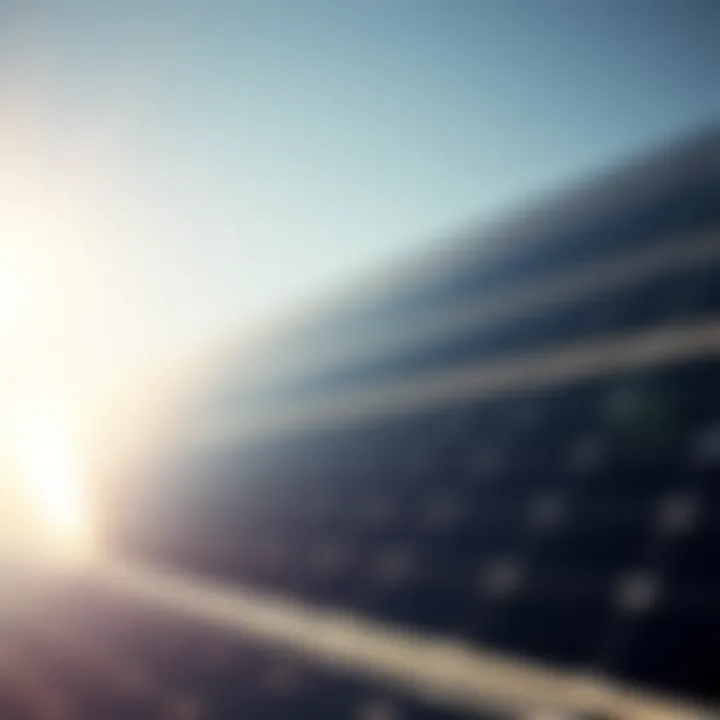Exploring Solar Energy Loan Rates for Investors


Intro
When it comes to harnessing the sun's energy, understanding solar energy loan rates can feel like navigating a maze. The landscape of solar financing can be a bit tricky for both seasoned investors and newcomers. Before investing in solar technology, it's essential to grasp the various financing options, rates, and their implications.
As the interest in renewable energy rises, so does the need to understand the nuances of solar loans. But why dive into the details of loan rates? Because the right financing can make or break your investment potential.
There's more than just monthly payments involved – factors such as credit scores, loan terms, and even government incentives play a role in determining what you'll pay over time. By breaking down these elements, our aim is to equip potential borrowers with the insights needed to make informed decisions about solar investments.
Foreword to Solar Energy Financing
In the context of today’s energy landscape, understanding solar energy financing is not just beneficial, it’s essential. Solar energy stands as a beacon of hope in our quest for sustainable and clean power solutions. With the ongoing debate surrounding climate change and energy independence, many individuals and businesses are leaning toward solar technology, seeking the dual benefits of reduced energy costs and environmental stewardship. This section aims to draw a clear picture of why engaging with solar energy financing is vital.
The Importance of Solar Energy
Solar energy has evolved significantly over the years, shifting from a niche market to mainstream acceptance. It offers an environmentally friendly alternative to fossil fuels, reducing greenhouse gas emissions while promoting renewable energy. Many communities across the globe are witnessing direct effects of solar adoption:
- Cost Savings: Homeowners who switch to solar can see a significant reduction in their monthly utility bills.
- Investment Potential: Installing solar panels can increase property value, making it a smart financial decision for many.
- Energy Independence: With solar, individuals can produce their own power, lessening dependence on fluctuating energy prices from local utilities.
The business case for solar is robust. As more companies pursue sustainability goals, they are turning to solar as a means to achieve both environmental and economic targets. This aspect is crucial because businesses are not just looking for short-term savings; they’re investing for the long haul.
Overview of Solar Energy Loans
Navigating the realm of solar financing is key to obtaining the best solar deal. Solar loans come in various forms, designed to meet diverse financial needs and situations. Here, we’ll take a glance at what these loans generally entail.
There are generally two main types of solar energy loans: secured and unsecured. Secured loans are backed by collateral, often resulting in lower interest rates. In contrast, unsecured loans typically don’t require collateral but may come with higher rates due to increased risk for lenders.
Consider this scenario: A homeowner opts for a secured solar loan by using their home equity. They tap into the existing value of their home to finance the installation of solar panels. This choice could lead to lower monthly payments long-term, especially if energy prices continue to rise.
Moreover, various loan options are available from traditional banks, credit unions, and even specialized lenders. Some organizations also offer unique programs that include benefits such as deferred payments, making solar financing even more accessible. It's crucial for potential borrowers to conduct thorough research and compare rates, terms, and conditions to ensure informed and beneficial decisions.
Understanding solar energy financing enables both individuals and businesses to effectively manage their investments in solar technology, paving the way for sustainable energy solutions.
Types of Solar Energy Loans
When considering solar energy as an investment, understanding the different types of loans available is paramount. Loan types can significantly affect the financing experience; they dictate terms, impact costs, and can influence the overall assessment of whether to go solar. This section aims to clarify the various loan options available to potential solar energy investors, each with its own merits and considerations.
Secured vs. Unsecured Loans
Secured loans are more like a safety net for lenders. They require some form of collateral, usually tied to the property being improved. This could be the house itself or another asset. Given the collateral, lenders typically offer lower interest rates, which can be quite appealing. However, if the borrower can't meet the payment deadlines, the lender can seize the collateral.
On the flip side, unsecured loans don’t require collateral. This can seem like a lifeline for those who don’t want to risk their property. Yet, this type often comes with higher interest rates due to the increased risk for lenders. Borrowers may need a strong credit history to qualify, as lenders want assurance they will get their money back – no safety net means more scrutiny.
In many cases, potential borrowers find themselves weighing the benefits of interest rates versus the risks of collateral loss, considering their financial situations and risk tolerance.
Home Equity Loans and Lines of Credit
Home equity loans and lines of credit (HELOCs) are two ways homeowners can tap into the value that has built up in their homes. They can be attractive options for those looking to finance solar installations, as they typically offer lower rates than standard personal loans.
A home equity loan is a lump sum borrowed against the equity in your home, which the borrower then pays back over a set term. It's like a second mortgage. This kind of loan can be advantageous for significant projects, such as installing an entire solar system, because it provides a sizable amount of upfront cash.
Conversely, a HELOC acts more like a credit card. You get a line of credit that lets you borrow as needed, paying interest only on the amount drawn. This can be beneficial for those who want the flexibility to fund their solar projects incrementally. However, since your house serves as collateral, defaulting on payments can lead to losing your home.
In either case, understanding the balance between risks and rewards is essential, as these loans can impact long-term financial health, especially in regard to home equity.
Personal Loans for Solar Energy
Personal loans for solar energy are straightforward and do not require any collateral. They come in handy for borrowers who may not want to put their home at risk. These loans can be secured quickly, and the approval process is generally simpler compared to home equity loans or lines of credit.
However, personal loans often pull higher interest rates, reflecting the lender's lack of security. Individuals with excellent credit may secure reasonable terms, but those with less-than-stellar credit could face significant financial burdens. Borrowers should carry out extensive research before committing to ensure they find a loan product that aligns with their financial goals, both immediate and future.
In summary, the type of solar energy loan one chooses plays a critical role in the financing experience. It can shape payment terms, impact the cost of borrowing, and ultimately affect the overall investment in solar energy. By considering the unique characteristics and implications of each loan type, borrowers can make informed and strategic decisions, paving the way for a greener future without straining their finances.
Factors Influencing Solar Energy Loan Rates
Understanding the factors that influence solar energy loan rates is crucial for anyone considering financing options for solar investments. Various elements come into play that can affect the rates borrowers encounter, impacting both individual and businesses' decisions. By doing so, it enables potential borrowers to make informed choices that align with their financial goals.


Credit Score Impact
One of the primary factors affecting loan rates is your credit score. Your credit score acts like a financial report card, detailing your borrowing history and repayment behavior. Lenders look at this number to gauge how risky it might be to lend you money. A higher score typically results in lower interest rates, while a lower score can lead to significantly higher rates or even disapproval for the loan.
- Why it matters: A good credit score can mean the difference between a top-tier interest rate and a rate that feels more like a punishment. For instance, someone with a credit score above 700 may secure rates as low as 3%, whereas someone with a score under 600 could face rates jumping to 8% or higher. This discrepancy can significantly affect the total repayment amount.
As such, if you're eyeing solar installations, maintaining or improving your credit score before applying for a loan is a wise strategy. Paying off outstanding debts and ensuring timely payments on existing loans can elevate your score, directly influencing the loan terms available to you.
Loan Term and Its Implications
The length of the loan, or the loan term, plays a pivotal role in determining your interest rates. Generally, shorter loan terms come with lower interest rates. For instance, if you take out a solar loan for five years instead of twenty, the immediate out-of-pocket cost may be more, but you'll pay less in interest overall.
- Considerations:
- Shorter loan terms tend to yield higher monthly payments but lower total interest paid in the long haul.
- Conversely, longer loan terms can result in lower monthly payments, making them seem financially easier to manage, but this often comes at the price of paying much more in total interest over time.
Taking into account your current financial situation and long-term goals is crucial when deciding on the loan term. It's worth running the numbers to see how different term lengths affect both your monthly budgeting and your financial health in the long run.
Market Conditions and Interest Rates
Lastly, broader market conditions significantly sway solar energy loan rates. In times of economic uncertainty, interest rates can fluctuate based on various external factors, such as inflation rates and the federal reserve's monetary policy decisions. Your prospective lender will adjust the loan rates they offer based on these variables.
- Influencing factors:
- Economic Growth: When the economy is on an upswing, consumers are more likely to spend, and lenders might raise rates in response to increased demand for loans.
- Inflation: Higher inflation generally results in higher interest rates, pushing up the cost of borrowed money.
- Government Policies: Incentives or changes in regulations affecting solar energy can lead to modifications in market dynamics. For instance, if the government increases its support for solar technology, this may lead to more favorable terms from lenders eager to promote green investments.
In the end, keeping an eye on the overall financial environment is not only sensible; it can save you significant amounts when borrowing for solar energy solutions.
Comparative Analysis of Loan Options
When considering solar energy financing, it's crucial to evaluate the various loan options available. Each option presents a unique set of terms, conditions, and potential benefits or drawbacks. Understanding these differences can be a game-changer for those seeking the best deal on their solar investment. This section aims to dissect two of the popular avenues for solar financing: banks and credit unions, and direct financing through solar providers.
Banks vs. Credit Unions
Banks and credit unions both offer loans for solar energy projects, yet they operate under different models which can significantly affect the terms of the loans provided.
- Interest Rates: Banks often offer competitive rates, but can have strinct eligibility requirements. Credit unions, on the other hand, tend to offer lower rates, yet their lending is generally more localized. Members often benefit from more personalized service and potentially better terms.
- Customer Service: Banks are typically larger institutions and can sometimes have customer service that feels less personal. Meanwhile, credit unions are often member-focused, and they may make the application process smoother.
- Loan Amounts: Depending on your project size, you might find banks willing to lend higher amounts, particularly for larger installations. Credit unions may cap loan amounts more frequently.
- Flexibility: Some credit unions may offer more tailored products. This means they could work with members to create loans that fit specific needs, unlike banks that rely on more standardized products.
Deciding between a bank and a credit union really comes down to personal preference and financial goals. If one is looking for higher loan amounts and typically good rates, a bank might be more suitable. Conversely, if personal service and community-focused lending matter more, a credit union could be the better choice.
Financing Through Solar Providers
Another option that has gained traction is obtaining financing directly through solar providers. This can streamline the process and provide certain advantages.
- Convenience: By financing through a solar provider, the steps are simpler. They handle not just the installation but the financial aspects too. It can feel like a one-stop-shop because everything is under one roof.
- Specialized Knowledge: Solar providers often have expertise in solar financing arrangements. They may offer loans or leases that are better structured specifically for solar energy projects.
- Promotions and Incentives: Many providers partner with financial institutions to offer incentives or rebates that can make financing through them more financially appealing.
- Variety of Options: Some solar companies offer various financing options like leases, power purchase agreements (PPAs), or loans tailored to the customer's needs. This flexibility can help customize the financing solution based on the borrower's unique situation.
However, there are potential downsides as well. Sometimes loan terms may be less favorable or come with hidden fees. Therefore, it's critical to read the fine print and understand the terms of any financing offer provided by solar companies.
"Choosing the right financing option involves weighing the nuances of different lenders against your own financial situation and goals."
For further reading and resources on solar financing, you might consider visiting these sites:
Energy.gov, Financing Solar, National Renewable Energy Laboratory
Application Process for Solar Loans
The application process for solar loans is crucial, as it determines the ease with which you can secure financing for your solar energy project. Understanding this process not only helps in getting the best rates but also ensures you’re prepared for what lenders will expect. Each stage of the application involves critical steps that, if navigated wisely, can lead to smoother sailing in your transition to solar energy. Here are the key elements to consider:
- Preliminary Research: Before diving into applications, researching potential lenders is key. Not all institutions offer the same rates or terms. Look for those that specialize in solar energy lending to find the most favorable conditions.
- Loan Types and Benefits: Knowing whether you want a secured or unsecured loan—and understanding the implications of each—can influence your application strategy. It might also dictate which lenders you want to pursue.
Overall, the application process is your first significant hurdle, and approaching it with the right knowledge can lead to successful solar financing.
Preparing Your Finances
Getting your finances in order is not just a box to tick; it’s the groundwork for a successful solar loan application. Here’s how to go about it:
- Check Your Credit Score: Before even thinking about applying, it’s vital to know where your credit stands. A good credit score can significantly lower interest rates, so if yours needs improvement, consider delaying your application until you’ve made some enhancements.
- Budgeting for Installation and Costs: Calculate all the costs involved in your solar project—installation, maintenance, and any ancillary costs. This information will help you determine how much financing you’ll need.
- Debt-to-Income Ratio: Lenders will want to know your debt-to-income ratio, as it reflects your ability to repay the loan. A lower ratio is favorable and shows lenders that you can handle additional debt.


These steps show lenders you’re prepared and have the means to manage the financial commitment.
Documentation Required
Each lender will have specific documentation requirements, but the following is generally expected:
- Proof of Income: Documentation verifying your income, such as pay stubs or tax returns, is essential. This shows your ability to repay the loan.
- Credit History: Lenders usually request your credit report, giving them insight into your financial reliability.
- Project Estimate: A detailed estimate from a solar contractor, outlining all projected costs of the solar system, helps lenders know exactly what they are financing.
- Personal Identification: Valid IDs, such as a driver’s license or passport, are typically required to confirm your identity.
Proper documentation is not simply red tape; it serves to paint a complete financial picture for lenders, facilitating the approval process.
These documents support your case and help avoid unnecessary roadblocks during your loan application process. Being prepared can save you time and headaches later.
Understanding Loan Terms and Conditions
When it comes to financing solar energy installations, grasping the key terms and conditions associated with the loans is crucial. These elements have a significant bearing on your overall financial commitment and can greatly influence your decision-making process. Understanding these terms can save you money and help you avoid pitfalls that could arise down the line.
Interest Rate Types
The interest rate is a fundamental aspect of any loan, including those for solar energy systems. There are generally two main types of interest rates: fixed and variable.
- Fixed Interest Rate: This type of rate remains constant throughout the life of the loan. This is advantageous for borrowers who appreciate predictability in their monthly payments, making it easier to budget. For instance, if you secure a fixed rate of 5% for 10 years, you'll know precisely how much you need to pay each month, regardless of fluctuations in the market.
- Variable Interest Rate: In contrast, this type of rate can change over the duration of the loan based on market conditions. While it might start lower than a fixed rate, there's always a risk that it could increase significantly over time. If the interest rate rises, borrowers will find their monthly payments might skyrocket as a result. A common example of this can be seen in loans that align with the LIBOR rate, which varies regularly based on economic conditions.
Understanding which type of interest rate fits best with your financial strategy is vital. A thorough assessment of your risk tolerance, market knowledge, and long-term financial planning should guide your decision. Evaluating both options puts you on a firmer footing.
Prepayment Penalties
Another crucial element to consider is the possibility of prepayment penalties. Such fees can apply if you decide to pay off your solar loan ahead of schedule. Here’s what you should know:
- What are Prepayment Penalties?: These are fees imposed by lenders when borrowers pay off their loans early. The rationale is that lenders lose interest income if loans are paid off sooner than expected.
- Impact on Financial Planning: If you've locked in a low interest rate, you may want to pay off your loan early to save on interest payments. However, if there's a hefty prepayment penalty, this might discourage that action. It’s essential to read the fine print and understand any penalties involved before signing on the dotted line.
- Negotiating Terms: Some lenders may allow for negotiation regarding prepayment penalties. If you’re set on paying off your loan early, it could serve you well to ask about options that minimize or eliminate these fees altogether.
"Understanding the intricacies of loan terms is pivotal for savvy financial planning, especially in the arena of solar energy financing."
Being aware of the nuances surrounding interest rates and prepayment penalties can empower you as a borrower. Take the time to scrutinize the terms and conditions laid out in your loan agreement. It's not just about securing a loan but ensuring it's the right fit for your financial goals in the long run.
Benefits of Solar Loans
When considering a shift towards solar energy, understanding the benefits of solar loans becomes paramount. In essence, these loans allow individuals and businesses alike to harness the sun's power without the immediate burden of upfront costs. Solar loans can bridge the gap between aspiration and reality, enabling homeowners to invest in renewable energy technology with financing options tailored to their financial situations.
Lower Energy Costs
One of the most attractive features of solar loans is how they can significantly lower energy costs over time. When you borrow money to install solar panels, you’re essentially investing in your future energy independence. Here’s how it works:
- Immediate Savings: Post-installation, many homeowners notice an immediate drop in their monthly energy bills. Although you will be making loan payments, the reduction in utility costs can often offset these payments, leading to net savings from day one.
- Long-term Stability: Solar energy provides a fixed cost against the fluctuating prices of fossil fuels, which can be volatile. Once your system is paid off, you're left with minimal ongoing costs, primarily maintenance.
- Return on Investment: Solar panel installations typically yield a return on investment that can outpace traditional investments. The long-term savings on electricity bills combined with potential tax incentives often make this a worthwhile financial decision. Investing in solar doesn't just save money; it's akin to investing in a savings account with guaranteed returns.
Environmental Considerations
In addition to financial incentive, solar loans pave the way for meaningful environmental considerations.
When individuals and businesses choose solar, they are actively participating in reducing carbon footprints and mitigating adverse climate impacts. Here’s how solar loans foster this essential shift:
- Sustainability: Transitioning to solar energy supports sustainability. By using renewable energy, the dependence on fossil fuels diminishes, reducing greenhouse gas emissions significantly.
- Energy Independence: Solar energy promotes energy autonomy. Homeowners no longer rely solely on utility companies, thus insuring against future energy price surges. Spreading out system costs through loans further enables investment into clean, domestic energy.
- Positive Impact on Communities: By investing in solar energy systems, individuals contribute to the building of a cleaner environment not only for themselves but for their communities, creating a ripple effect of sustainability.
"Every dollar spent on solar energy not only fosters personal savings but also contributes towards a sustainable planet for future generations."
In summation, solar loans offer benefits that go beyond personal finance. They represent an opportunity for individuals to contribute positively toward the environment while benefiting from significant financial returns. As more people gain insight into these advantages, solar energy is poised to take an even larger role in our collective energy strategy.
For additional details on solar initiatives and benefits, consider visiting the U.S. Department of Energy at *.gov for more insights and resources.
Challenges in Solar Financing
When embarking on the journey of financing solar energy solutions, one must navigate a rather complex landscape. The solar financing arena, while burgeoning with opportunities, is not without its fair share of bumps in the road. Understanding these challenges is pivotal for anyone considering solar investments, as they directly influence both decision-making and financial outcomes.
Understanding the Risks
Navigating solar financing means getting acquainted with various risks that can derail your investment. For starters, one prominent risk is fluctuating interest rates. If a borrower secures a loan with a variable interest rate and the market shifts, they could find themselves paying significantly more over time. This unpredictability emphasizes the importance of considering fixed-rate loans, where the rate is locked in, offering borrowers peace of mind.


Moreover, the risk associated with solar technology itself cannot be overlooked. Not all solar panels and inverters are created equal. The durability and performance of the technology you choose can swing your return on investment dramatically. It's crucial to conduct thorough research into the brands and products you are considering to mitigate this risk.
Lastly, the ability to repay the loan can also be a concern. Economic shifts or personal financial changes can put an unexpected strain on budgets, affecting the borrower's ability to meet obligations. Factors such as job security or unexpected expenses must be factored into the financial equation before taking the plunge into a solar loan.
Understanding these risks can ultimately steer potential borrowers towards making informed, conscientious choices regarding their solar financing options.
Regulatory Considerations
The regulatory environment surrounding solar financing is another layer of complexity. Different states may offer varying incentives, credits, and rebates that can affect the net costs associated with solar installations. These financial incentives can significantly alter the overall landscape, and missing out on them could lead to higher-than-necessary costs.
It’s also essential to be aware of any recent changes in laws and policies. Solar financing can be impacted by government regulations, which can be both a blessing and a curse. For instance, some administrations prioritize renewable energy and create supportive policies that ease financing, while others may impose restrictions or reduce available incentives that can negatively affect financing conditions.
Moreover, navigating compliance requirements can feel like a maze. Borrowers must ensure they’re abiding by local, state, and federal laws, which can include zoning laws, building permits, and even homeowner association rules. Failing to comply with these regulations can lead to delays, fines, or even the inability to secure financing.
Understanding both the risks and regulatory considerations not only prepares potential solar investors for what lies ahead but also arms them with the information necessary to make informed decisions, thus paving the way for sustainable financial growth.
Current Trends in Solar Loan Rates
The ongoing fluctuations in solar loan rates present crucial insights for potential borrowers and investors. Understanding these trends is not just for the savvy finance enthusiast; it's about being equipped to make informed decisions amidst an evolving landscape.
Technological Advancements
Innovations in solar technology are making headway, creating a ripple effect in the financing options available. For instance, solar panels are becoming more efficient, pushing energy costs down. New materials, like perovskite, used in solar cells are emerging, promising even higher efficiency at a lower production cost.
This drop in costs not only affects installation prices but also the overall return on investment for solar projects. When a new tech hits the market, lenders often adjust their interest rates accordingly. Lower risk for lenders translates into more favorable loan terms for borrowers. Interest rates may feel the heat, dropping in response to these advancements and enticing more individuals to invest in solar.
"In the world of finance, change is the only constant, especially when technology leaps forward."
Moreover, improvements in energy storage, such as lithium-ion batteries, have reshaped how people perceive solar energy's reliability. These developments allow homeowners to store energy produced during sunny days for use at night or in cloudy weather. It’s not just about harnessing the sun; it’s also about using it effectively.
Government Incentives and Support
Government policies play a pivotal role in the landscape of solar financing. Various incentives range from tax credits to rebates can significantly influence the overall cost of adopting solar energy solutions. For example, the federal investment tax credit (ITC) allows borrowers to deduct a substantial percentage of their solar system costs from their federal taxes.
As jurisdictions aim to meet renewable energy targets, many local and state governments are stepping up with support programs. These initiatives can lower the effective interest rates on solar loans substantially. Some programs even offer grants for households and businesses to help cover the initial costs of installation and financing.
- Tax Credits: Lower effective costs through deductions.
- Rebates: Cash rewards for making the switch to solar energy.
- Local Programs: Targeted initiatives to boost adoption.
Navigating through these incentives can be the difference between a hesitant decision to invest and a confident leap forward into solar. Staying up-to-date with new regulations and financial opportunities can empower potential investors to harness the benefits and minimize their costs. Checking resources like DSIRE can provide ongoing information about local incentives.
In summary, understanding the interplay between technological advancements and government incentives simplifies the often complex world of solar loan rates. It’s these factors that paint a clearer picture of what to expect in the future and how best to prepare for it.
Closure and Next Steps
In wrapping up this exploration of solar energy loan rates, it's crucial to underscore the significance of this topic in the broader context of energy investments. Solar energy isn't just a trend; it’s a substantial financial commitment and a meaningful step toward sustainability. As you've journeyed through the various sections, you’ve likely come to appreciate the multitude of financing options available, each tailored to different circumstances and needs. The knowledge gained here arms you with the ability to navigate this complex landscape better.
Going beyond just acquiring solar systems, understanding loan rates alongside their advantages and challenges provides a clearer view of potential outcomes. Each choice, from secured loans to personal loans, comes with its own set of terms, rates, and implications that can shape your financial health.
As you contemplate your next steps in the realm of solar energy financing, consider the following elements:
- Assess Your Financial Health: Before diving into any loan, take stock of your current financial condition. What’s your credit score? How much can you afford to pay monthly?
- Identify Goals: Are you primarily interested in reducing energy costs, or are environmental benefits at the forefront? Your goals will guide your decision.
- Stay Informed: Market conditions can shift unexpectedly. Staying updated on trends can give you an edge when negotiating your loan.
The decisions you make now could set the tone for your investments in renewable energy. It’s not merely about making an immediate purchase; it’s about anticipating how these choices can affect your long-term financial strategy.
Evaluating Your Options
When it comes to financing solar energy, careful evaluation is paramount. You hold a variety of options, each with its own advantages and drawbacks. It’s akin to picking a path on a forked road—each one leads to different destinations with varying challenges along the way. As you weigh your options, consider:
- Interest Rates: The better your credit score, the more favorable rates you can potentially secure. Investigate both fixed and variable rates to identify what suits your overall financial strategy.
- Loan Terms: Shorter terms mean higher monthly payments but potentially less interest over the life of the loan.
- Fees and Penalties: Watch out for hidden costs including origination fees, prepayment penalties, and other charges that can increase your total cost.
- Lender Reputation: It's not just about who offers the lowest rate. Take time to research lenders’ reviews, customer service quality, and overall reliability.
Engaging with Financial Advisors
Consulting a financial advisor can significantly enhance your understanding of solar loans. These experts can help you tailor your choices to fit your unique financial circumstances and goals. Here's how to make the most of their guidance:
- Prepare for Your Meeting: Before your consultation, gather your financial documents, including income records, credit reports, and existing debts. This will equip your advisor to provide tailored advice.
- Ask Specific Questions: Inquire about loan options, potential risks, and strategies for lowering your overall costs. The more clarity you have, the better decisions you can make.
- Understand Complex Terms: Some loan terms can be confusing. A good advisor should help break down these complexities into manageable insights.
- Follow Up: After your consultation, don’t hesitate to reach out for clarification on any lingering uncertainties.
Engaging with a financial advisor may seem like an extra step, but the peace of mind it brings could be invaluable as you navigate the process of securing a solar loan. Remember, it’s your investment and future, and it’s worth taking the time to do it right.
For more in-depth information about financing solar energy systems, you may refer to resources such as Investopedia, or the U.S. Department of Energy.
"Investing in solar energy isn't just about money; it’s about the power to shape a sustainable future. Make choices that reflect your values."
People who adopt a careful, informed approach typically reap the benefits, and setting the stage for your energy financing adventure should start with a well-thought-out plan.















